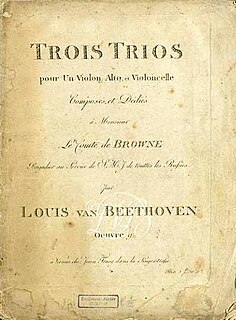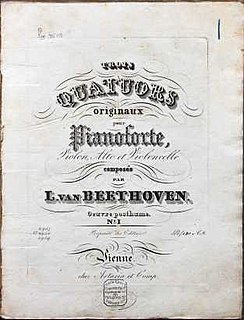Related Research Articles

Ludwig van Beethoven was a German composer and pianist whose music ranks amongst the most performed of the classical music repertoire; he remains one of the most admired composers in the history of Western music. His works span the transition from the classical period to the romantic era in classical music. His career has conventionally been divided into early, middle, and late periods. The "early" period, during which he forged his craft, is typically considered to have lasted until 1802. His "middle" period, sometimes characterized as "heroic", showed an individual development from the "classical" styles of Joseph Haydn and Wolfgang Amadeus Mozart, typically covers the years 1802 to 1812, during which he increasingly suffered from deafness. In the "late" period from 1812 to his death in 1827, he extended his innovations in musical form and expression.

Ferdinand Ries was a German composer. Ries was a friend, pupil and secretary of Ludwig van Beethoven. He composed eight symphonies, a violin concerto, eight piano concertos, three operas, and numerous other works, including 26 string quartets. In 1838 he published a collection of reminiscences of his teacher Beethoven, co-written with Franz Wegeler. The symphonies, some chamber works—most of them with piano—his violin concerto and his piano concertos have been recorded, exhibiting a style which, given his connection to Beethoven, lies between the Classical and early Romantic styles.
The Septet in E-flat major, Opus 20, by Ludwig van Beethoven, was sketched out in 1799, completed, and first performed in 1800 and published in 1802. The score contains the notation: "Der Kaiserin Maria Theresia gewidmet", or translated, "Dedicated to the Empress Maria Theresa."
The Serenade in D major for Violin, Viola and Cello, Op. 8, is a string trio composition by Ludwig van Beethoven. It was written from 1796–97, and published in 1797 by Artaria in Vienna.
Ludwig van Beethoven composed his Horn Sonata in F major, Op. 17 in 1800 for the virtuoso horn player Giovanni Punto. It was premiered with Punto as the soloist, accompanied on the piano by Beethoven himself in Vienna on April 18, 1800.
Ludwig van Beethoven's Rondo for Piano and Orchestra in B-flat major, WoO 6 was composed in 1793 and originally intended as the final movement for his second piano concerto. Hans-Werner Küthen states this was probably the finale for the first and second versions of the second piano concerto, being replaced by the final version of the rondo in 1795. He also notes that the most likely inspiration for the insertion of an andante section into the rondo is the concluding rondo of Mozart's Piano Concerto No. 22.
The Three Piano Sonatas, WoO 47, were composed by Ludwig van Beethoven in 1782 and 1783, when he was eleven and twelve years old. The sonatas show a certain level of precocity and serve as a precursor to the masterworks he later produced. They are dedicated to the Prince elector Maximilian Frederick and therefore also known as the "Kurfürstensonaten".

The three String Trios, Op. 9 were composed by Ludwig van Beethoven in 1797–98. He published them in Vienna in 1799, with a dedication to his patron Count Johann Georg von Browne (1767–1827). They were first performed by the violinist Ignaz Schuppanzigh with two colleagues from his string quartet. According to the violinist and conductor Angus Watson, these were probably Franz Weiss on viola and either Nikolaus Kraft or his father Anton on cello. Each of the trios consists of four movements:
Written in 1846, the Piano Trio in G minor, opus 17 by Clara Schumann was her only piano trio and was composed during her stay in Dresden 1845-1846. During the development of the Trio, she was going through hardships in life. Her husband Robert Schumann was extremely ill. This trio was completed during the summer of 1846 when they traveled to Norderney in attempts to improve Robert's health conditions. While in Norderney, Clara suffered from miscarriage. A year after the composition of her piano trio, Robert composed his first piano trio, op.63. It is seen that Clara's trio has had great influences on Robert's trio as they both share many interesting similarities. Their works were frequently paired at concerts.
The Trio for piano, flute and bassoon in G major, WoO. 37 is a composition for piano trio by Ludwig van Beethoven that was discovered amongst Beethoven's papers following his death. Believed to have been composed in his teens and demonstrating the influence of Mozart, the composition remained unpublished until 1888, when it was published in the supplement to the complete set of the composers works by Breitkopf & Härtel.
The Piano Trio in E-flat major, WoO. 38 is a composition for piano trio by Ludwig van Beethoven, that was discovered amongst Beethoven's papers following his death. It is believed to have been composed in either 1790 or 1791. More conventional in nature than the Piano Trios Op.1, the composition was not published until 1830 by F. P. Dunst in Frankfurt, along with the Allegretto for Piano Trio in B-flat major, WoO. 39 and Piano Sonata in C major, WoO. 51.
The Piano Sonata in C major, WoO. 51 is an incomplete composition for piano by Ludwig van Beethoven, believed to have been composed before he left Bonn, that was discovered amongst Beethoven's papers following his death. The composition was not published until 1830 by F. P. Dunst in Frankfurt, with a dedication to Eleonore von Breuning, along with the piano trios WoO. 38 and WoO. 39.
The Flute Sonata in B-flat major, Anh. 4 is a composition for flute and keyboard attributed to Ludwig van Beethoven found amongst his papers after his death. It remained unpublished until 1906.
The String Trio in E-flat major, Op. 3 is a composition by Ludwig van Beethoven, his first for string trio.
In art, a dedication is the creation or attribution of a work of art as a tribute to or in honor of a person, place, or thing. The dedicatee may be the commissioner, conductor, premiere performer or musical ensemble, or patron. The work may be memorial.
The Sonatensatz in B-flat major D. 28, also known as Piano Trio in B-flat major, is a single-movement work for piano trio by Franz Schubert.
The Sonata in B-flat major for piano four-hands, D 617 by Franz Schubert, is the first of two sonatas for two pianists the composer wrote in his lifetime, the other being the Grand Duo of 1824.
Ferdinand Ries's Cello Sonata in G minor, Op. 125 was composed in London in 1823, but was not published until 1825 by T. Boosey & Co. It is one of the last two instrumental sonatas published by the composer before his death in 1838.

The Piano Quartets, WoO 36, by Ludwig van Beethoven are a set of three piano quartets, completed in 1785 when the composer was aged 15. They are scored for piano, violin, viola and cello. He composed a quartet in C major, another in E-flat major, and a third in D major. They were first published posthumously in 1828, however numbered in a different order: Piano Quartet No. 1 in E-flat major, Piano Quartet No. 2 in D major, and Piano Quartet No. 3 in C major.
References
- Notes
- ↑ Anderson 2007
- 1 2 Cooper 2000 , p. 225
- ↑ Heibert 1970 , p. 168
- ↑ Watson 2012 , p. 193
- Sources
- Anderson, Keith (1994). Beethoven: Archduke Trio / Kakadu Variations / Allegretto, WoO 39 (CD). Naxos Records. 8.550949.
- Anderson, Keith (2007). Beethoven: Piano Trios, Vol. 2 - Piano Trios Nos. 1, 2, 9 (CD). Naxos Records. 8.572343.
- Cooper, Barry (2000). Beethoven . United States: Oxford University Press. ISBN 0191592706.
- Hiebert, Elfrieda Franz (1970). The Piano Trios of Beethoven: An Historical and Analytical Study. University Microfilms.
- Watson, Angus (2012). Beethoven's Chamber Music in Context. Woodbridge: Boydell Press. ISBN 978-1-84383-716-9.
- Wigmore, Richard (2011). Beethoven: The Complete Music for Piano Trio (PDF) (CD). Hyperion Records. CDS44471/4.